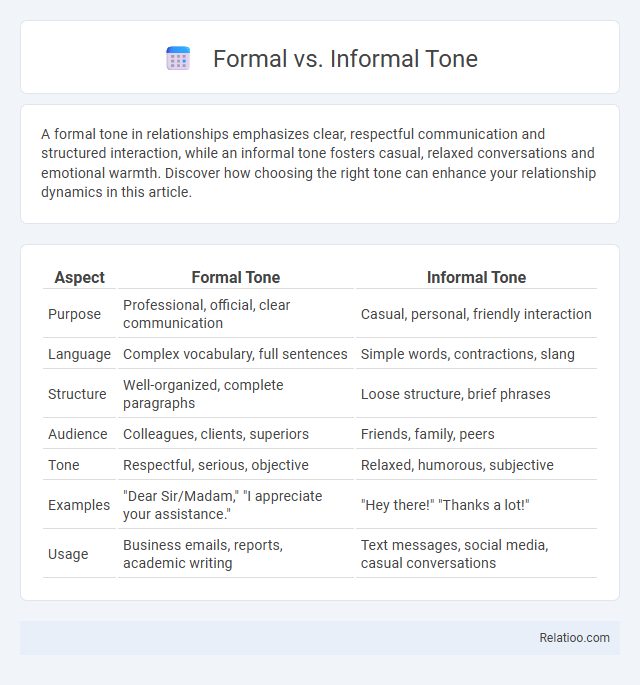A formal tone in relationships emphasizes clear, respectful communication and structured interaction, while an informal tone fosters casual, relaxed conversations and emotional warmth. Discover how choosing the right tone can enhance your relationship dynamics in this article.
Table of Comparison
| Aspect | Formal Tone | Informal Tone |
|---|---|---|
| Purpose | Professional, official, clear communication | Casual, personal, friendly interaction |
| Language | Complex vocabulary, full sentences | Simple words, contractions, slang |
| Structure | Well-organized, complete paragraphs | Loose structure, brief phrases |
| Audience | Colleagues, clients, superiors | Friends, family, peers |
| Tone | Respectful, serious, objective | Relaxed, humorous, subjective |
| Examples | "Dear Sir/Madam," "I appreciate your assistance." | "Hey there!" "Thanks a lot!" |
| Usage | Business emails, reports, academic writing | Text messages, social media, casual conversations |
Introduction to Formal and Informal Tone
Understanding the distinction between formal and informal tone is crucial for effective communication in various contexts. Formal tone employs precise language, polite expressions, and structured sentences, often used in professional or academic settings. Informal tone, on the other hand, features conversational language and relaxed expressions, making your message more relatable and personal.
Defining Formal Tone
Formal tone employs structured language, precise vocabulary, and professional expressions to convey respect and clarity, often used in academic, legal, or business communication. Unlike informal tone, which features casual language, contractions, and colloquialisms to create a friendly and approachable atmosphere, formal tone maintains objectivity and seriousness. Your choice between formal and informal tone depends on the context, audience, and purpose of your message to ensure effective communication.
Understanding Informal Tone
Understanding informal tone involves recognizing its casual, conversational style often used in personal communication and social media. It features relaxed grammar, contractions, slang, and emotive language to create a friendly and approachable atmosphere. This tone contrasts with formal tone, which employs precise vocabulary and structured sentences suitable for professional or academic contexts.
Key Differences Between Formal and Informal Tone
Formal tone employs precise vocabulary, structured sentences, and professional language suited for academic or business contexts. Informal tone uses conversational language, contractions, and slang, creating a relaxed and friendly atmosphere. Key differences include audience, purpose, and the level of politeness or professionalism conveyed.
When to Use a Formal Tone
A formal tone is essential in professional settings such as business communications, academic writing, and official documents where clarity, respect, and professionalism are paramount. You should use a formal tone when addressing colleagues, clients, or superiors to establish credibility and convey seriousness. In contrast, an informal tone suits personal interactions and casual conversations, but it may undermine your message in situations requiring authority and precision.
Situations Best Suited for an Informal Tone
An informal tone is best suited for casual conversations, personal emails, social media interactions, and creative writing where a relaxed and friendly style helps engage your audience effectively. Your message can become more relatable and approachable when using informal language in situations such as chatting with friends, providing customer support in a conversational manner, or creating content for younger demographics. This tone fosters a sense of familiarity and ease that formal language often lacks in these contexts.
Advantages of Formal Communication
Formal communication enhances clarity and professionalism, establishing trust and credibility in business interactions. It ensures precise messaging and reduces misunderstandings by adhering to structured language and etiquette. Your ability to convey complex information effectively is strengthened, supporting successful decision-making and collaborative efforts.
Benefits of Informal Communication
Informal communication fosters a more relaxed and approachable atmosphere, enhancing team collaboration and creativity by encouraging open dialogue. It accelerates decision-making processes through quicker exchanges, reducing misunderstandings commonly associated with rigid formal language. Relationships strengthen as informal tone builds trust and rapport, promoting higher employee engagement and job satisfaction.
Common Mistakes in Tone Selection
Choosing between formal and informal tone hinges on understanding context and audience, but common mistakes include overusing jargon in formal writing that alienates readers and employing overly casual language in professional settings that undermines credibility. You risk miscommunication when the tone does not align with the intended message, leading to confusion or perceived disrespect. Ensuring tone consistency enhances clarity, professionalism, and engagement across various communication platforms.
Tips for Choosing the Appropriate Tone
Choosing the appropriate tone depends on your audience, purpose, and context; formal tone suits professional or academic settings where clarity and respect are paramount, while informal tone works best for casual, friendly communication that builds rapport. Consider your reader's expectations and the message's intent to maintain engagement without misunderstanding. Tailoring your tone ensures your message resonates effectively with your audience and strengthens your communication impact.

Infographic: Formal vs Informal Tone
 relatioo.com
relatioo.com